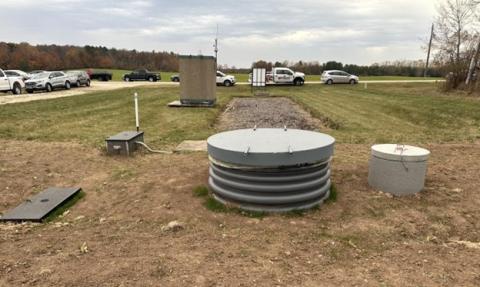It was a chilly fall evening with rain clouds rolling in, yet nearly 30 people gathered for a Wisconsin Demonstration Farm Network Field Day in northeastern Wisconsin to learn about the newest technology adopted by Lee Kinnard of Kinnard Farms. As a member of the Door-Kewaunee Demonstration Farms Network (DK Demo Farms) and Peninsula Pride Farms, Kinnard partnered with U.S. Department of Agriculture (USDA) Natural Resources Conservation Service (NRCS) and U.S. Geological Survey (USGS) to be one of the first in the nation to have a denitrifying bioreactor and a phosphorus removal system (PRS) built in-line on the same tile system within a field. For the first time, the USGS will be able to monitor the system at three different points, collecting data that will help tell a more complete story about the impact of pairing these two technologies on subsurface water quality.
USGS has been conducting edge-of-field monitoring to assess the quantity and quality of agricultural runoff; and, since 2018, when the bioreactor was installed at Kinnard Farms, USGS has been evaluating the effectiveness of conservation practices designed to reduce nutrient loss. The bioreactor was installed with technical and financial assistance from NRCS through the Environmental Quality Incentives Program and funding from the Great Lakes Restoration Initiative (GLRI)."[Now] data will be collected as water leaves the field through the tile system and enters the PRS (phosphorus removal system), as it leaves the PRS and enters the bioreactor, and when it leaves the bioreactor,” explained Joe Van Hulle, an engineer with NRCS Wisconsin.
As part of the DK Demo Farms, which is funded through GLRI, Kinnard says keeping soil and nutrients out of Green Bay and Lake Michigan is what drives him to try new practices on his farm. “Regenerative practices like planting cover crops and no-till farming are really working, but we know that tile system needs to be a part of the solution, and we want to make sure we’re not replacing one problem with another.” Implementing the bioreactor was the first step, but having the opportunity to pair that with a system designed to remove dissolved phosphorus could be a potential game changer for this region of the state. Read the full story about the initiative.



